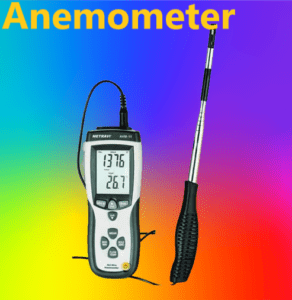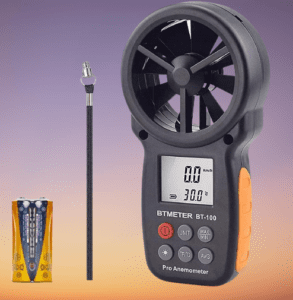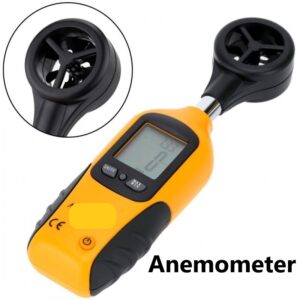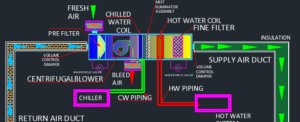An Anemometer is a scientific instrument designed to measure and quantify the speed or velocity of the wind or air. It is widely used in meteorology, environmental studies, wind energy assessment, aviation, and various other fields where knowledge of wind speed is essential. Anemometers come in different types, each utilizing various principles and mechanisms to accurately gauge the intensity of the wind’s movement, providing valuable data for research, forecasting, and practical applications.
Working principle of the Anemometer
The working principle of the anemometer, an ingenious device harnessed to measure the speed and direction of the wind, is rooted in the art of aerodynamics and fluid mechanics.

- Cup Anemometer:
- The classic cup anemometr, a marvel of simplicity, comprises three or four cups arranged symmetrically on horizontal arms. As the wind caresses the cups, they begin to rotate, propelled by the force of the wind’s momentum. The rate of rotation is directly proportional to the wind speed, and this angular velocity can be converted into wind speed measurements.
- Vane Anemometer:
- In the case of the vane anemometr, elegance meets precision. It consists of a freely rotating vane atop a vertical axis. When the wind encounters the vane, it exerts a turning force, causing the vane to align itself with the wind’s direction. The angle of displacement of the vane from its original position provides valuable data on the wind’s direction.

- Hot-Wire Anemometer:
- Diving into more modern territory, the hot-wire anemometr embraces cutting-edge technology. A thin, electrically-heated wire, often made of platinum, is suspended in the wind’s path. As the wind flows over the wire, it cools the wire down, and the electrical resistance changes proportionally to the wind speed. By monitoring the variations in electrical resistance, the anemometer can precisely gauge the wind’s velocity.
- Ultrasonic Anemometer:
- The ultrasonic anemometr epitomizes innovation with its non-intrusive design. Utilizing ultrasonic signals, it measures the speed and direction of the wind with great accuracy. This anemometr employs pairs of transducers positioned at specific distances from each other. The ultrasonic signals travel between transducers, and the time taken for the signal to traverse the distance is influenced by the wind speed. By analyzing the time differences, the anemometr deduces the wind’s velocity and direction.
Uses of the Anemometer
Applications of the Anemometer:
| Application | Description |
|---|---|
| Weather Forecasting | Anemometrs provide crucial data for predicting weather patterns and conditions, aiding in accurate weather forecasts. |
| Aviation and Aerospace | In aviation and aerospace industries, anemometrs help pilots and engineers understand wind conditions during flight and aircraft design. |
| Wind Energy | Anemometrs are essential in wind energy production, helping optimize turbine performance and determining suitable locations for wind farms. |
| Environmental Monitoring | Anemometrs play a role in monitoring air quality and pollution dispersion, providing data for environmental impact assessments. |
| Climatology | Anemometrs contribute to climatological research, helping scientists study wind patterns and their influence on climate dynamics. |
| Building Construction | During construction, anemometrs aid in assessing wind loads on buildings and structures, ensuring structural safety and stability. |
| Maritime and Navigation | Anemometrs assist maritime navigation by providing real-time wind data for ship captains and sailors, aiding in efficient and safe sailing. |
| Sports and Recreation | In sports like sailing, windsurfing, and paragliding, anemometrs help enthusiasts gauge wind conditions, ensuring safer and enjoyable experiences. |
| Research and Education | Anemometrs are used extensively in educational settings and research facilities to study fluid dynamics, aerodynamics, and meteorology. |
| Renewable Energy Projects | For other renewable energy projects like solar panel orientation, anemometrs aid in optimizing energy production by assessing wind influence. |
Frequently Asked Questions:
What is an Anemometer?
Answer: An Anemometr is a scientific instrument used to measure the speed and direction of the wind.
What are the primary types of Anemometers?
Answer: The primary types of Anemometrs include cup anemometr, vane anemometr, hot-wire anemometr, ultrasonic anemometr, laser Doppler anemometr (LDA), sonic anemometr, pressure tube anemometr (Pitot tube), and windmill anemometr.
How does a cup anemometer work?
Answer: A cup anemomeer consists of rotating cups on horizontal arms. The cups rotate with the wind, and the rate of rotation is directly proportional to the wind speed, allowing for wind speed measurement.
What principle does the hot-wire anemometer rely on?
Answer: The hot-wire anemometr relies on the principle that wind flow cools down a thin, electrically-heated wire. The change in electrical resistance of the wire is used to determine wind speed.
How does an ultrasonic anemometer measure wind speed and direction?
Answer: An ultrasonic anemometr uses ultrasonic signals between pairs of transducers positioned at specific distances. By analyzing the time differences of the signals, wind speed and direction are determined.
What is the purpose of a vane anemometer?
Answer: A vane anemometr is employed to measure wind direction. Its freely rotating vane aligns itself with the wind direction, and the angle of displacement provides wind direction data.
What are the common applications of anemometers?
Answer: Anemometrs find applications in weather forecasting, wind energy assessment, aviation, environmental monitoring, climatology, building construction, maritime navigation, sports and recreation, research, and education.
How do anemometers aid in wind energy projects?
Answer: Anemometrs are essential in wind energy projects to assess wind resources, optimize turbine placement, and design, ensuring efficient energy production.
How are anemometers used in weather forecasting?
Answer: In weather forecasting, anemometrs provide critical wind data, which helps meteorologists understand atmospheric conditions and predict weather patterns.
What is the significance of anemometers in aviation?
Answer: Anemometrs play a crucial role in aviation by providing real-time wind data, and helping pilots and engineers make informed decisions during flight, takeoff, landing, and aircraft design.

